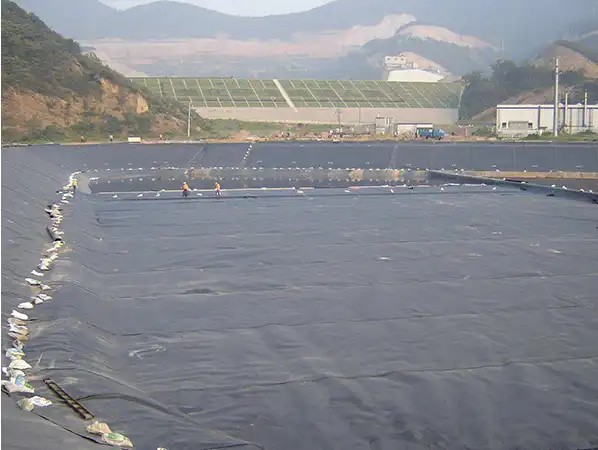
Due to the production of a large amount of wastewater that is harmful to the environment in the chemical industry, the anti-seepage performance of sewage tanks has become an important indicator. Due to its excellent plasticity and chemical stability, HDPE anti-seepage geomembrane can resist corrosion from over 80 strong acidic and alkaline chemical media such as acids, alkalis, salts, and oils. Therefore, it has been widely used in fields such as chemical engineering and sewage treatment.
Construction procedure for HDPE anti-seepage geomembrane:
Surface requirements for anti-seepage and chemical anti-corrosion engineering of sewage tanks
1. Chemical wastewater tanks are mostly of mixed soil structure, with a relatively flat surface. It is only necessary to pay attention to cleaning debris such as debris, stones, steel reinforcement heads, and glass shavings inside the tank.
2. The corners of the base surface should have a smooth transition, and the base of the column should be made into a circular arc shape.
3. After the acceptance and signature of the civil engineering, supervision, owner, and construction party, the construction of geomembrane can be carried out
The laying of HDPE anti-seepage geomembrane
Laying HDPE anti-seepage membrane is a crucial process in the entire anti-seepage system.
Before laying the membrane, open the package to inspect the appearance quality of the anti-seepage membrane, record and repair any mechanical damage, production trauma, holes, folds, and other defects that have been found.
Before cutting the anti-seepage membrane, its relevant dimensions are measured, and then cut according to the actual situation. During the laying of the membrane, the overlap width between the membrane and the membrane should not be less than 100mm, so that the joint arrangement direction is parallel to the foot line of the large slope, that is, arranged along the slope direction.
When laying impermeable membranes, efforts should be made to minimize the number of welds and save raw materials as much as possible while ensuring quality. It is also easy to ensure quality.
Usually, in corners and deformed areas, the joint length should be minimized as much as possible. Unless otherwise specified, welding seams should be avoided as much as possible within a range of 1.5 meters from the top slope or stress concentration area on slopes with a slope greater than 1:6.
During the laying of the anti-seepage membrane, artificial wrinkles should be avoided. When the temperature is low, it should be tightened and laid flat as much as possible.
After the completion of the anti-seepage membrane installation, walking and moving tools on the membrane surface should be minimized as much as possible. Any objects that can cause harm to the HDPE membrane should not be placed or carried on the membrane to avoid accidental damage to the membrane.
Welding of HDPE anti-seepage geomembrane
The welding of the anti-seepage membrane is carried out using a wedge welding machine and a dual track hot melt welding method. For areas that cannot be welded by a wedge welding machine, an extrusion hot melt welding machine should be used, accompanied by welding rods of the same quality as the raw materials, to form a single weld seam for overlay welding.
1. The welding process of the hot wedge welding machine is divided into: adjusting pressure, setting temperature, setting speed, inspecting weld overlap, installing film into the machine, and starting the motor.
2. There should be no oil stains or dust at the joints, and the overlapping surface of the anti-seepage membrane should not have debris such as mud, dew, or moisture. When there are debris, they must be cleaned before welding.
3. At the beginning of welding every day, it is usually necessary to conduct a trial welding of 0.9mm on site first × A 0.3mm specimen with a lap width of no less than 10cm shall be subjected to peel and shear tests on site. Once the specimen is qualified, it can be welded using the adjusted speed, pressure, and temperature at that time. During the welding process, it is necessary to pay attention to the operation of the hot wedge welding machine at all times, based on the actual situation on site
.png)
.png)












